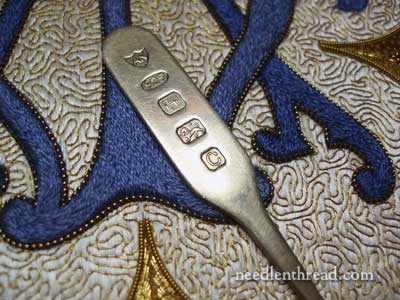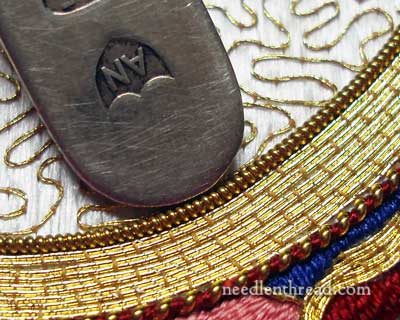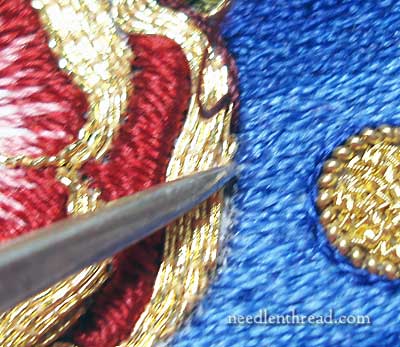A mellor is a goldwork tool. I’ve seen it spelled “mellor” and “melore” and “mellore,” depending on the source. Today, I’m calling it a mellor. Tomorrow, I might call it a mellore. I think it’s too late to dictate the absolute spelling of the thing. But however it is spelled, the mellor is a tool used in goldwork, and it’s a handy little thing to have.
Since we all have our Favorite Tools (and I’m pretty sure many stitchers become inordinately attached to certain tools, so much so that life would alter significantly without them), you can take or leave my assertions about the mellor. You see, I’m inordinately attached to certain tools, and I’m fiercely loyal to them. Insult my tools, and you insult me, says I. I stand up for my tools. I fight for them – Stiletto Wars to the Death!
Ok, ok! Perhaps I wouldn’t go that far, but I do like my tools, and there’s a reason I like them. So let’s talk about the mellor-melore-mellore.

My mellor, I adore. It helps me do more. It makes my heart soar. How I love thee, my mellor!
The mellor is paddle shaped on one end and pointed on the other. It’s used to manipulate goldwork threads so that the stitcher handles the threads less.
The mellor you see above is made of sterling silver. Besides giving one the ability to be able to say in slightly superior tones, “Oh, yes. That is my mellor, and it is made of Sterling Silvah” (as if that’s some claim to tool superiority), there is a reason the mellor is made of sterling silver. It isn’t a Snob Thing. It’s a Tool Thing. The mellor is meant to poke and prod relatively delicate goldwork threads. Silver is a softer metal than stainless steel. Silver is apparently a bit gentler on gold threads, compared to stainless steel. And hence, the silver mellor.
That being said, there is a stainless steel version of the mellor available out there, and it is shaped the same way and is made to do the same things. It does have a hole in the paddle end of it, though, and this is a puzzlement to me. The hole is meant to make it attachable to a chain or chatelaine. But if the paddle end is used regularly (I use it more than the pointed end, personally), I would find the presence of a chain through a hole in the paddle a bit of a bother.

The paddle end of the mellor is curved and smooth, with blunt rounded edges (no squared edges). This makes it perfect for pushing and prodding gold threads into line.

The pointed end of the mellor can be used as well to poke and prod goldwork threads. I use it to hold threads out of the way, or to prod threads in tight spaces, where the paddle end doesn’t fit. The pointed end can also be used to widen plunging holes, when plunging heavier threads. Though the mellor has a blunt tip, the tapered little shaft will create a larger hole when it is pushed into the fabric. This end of the mellor can also be used as a laying tool. Personally, I prefer a longer laying tool (the tapered end of the mellor is rather short), but I’ve used it as a laying tool and it does work.
Here’s the question: Is a mellor necessary?
If you’re just getting into goldwork, I’d say no, it is not absolutely necessary. You can achieve many of the same results with the blunt back end of a pair of tweezers that you can achieve with a mellor (though that wider paddle end does come in really handy when prodding lines of thread!). And as for the tip of the mellor, you can achieve many of the same results with the front end of a pair of blunt tweezers.
Will the mellor become more necessary as you progress in goldwork? Yes, I think so. Sure, you can do goldwork without it altogether. But I have this thing about tools: I’m a firm believer that the right tools make the job easier. And the mellor is a great tool for stitchers who work with metal threads. It’s designed just for this type of embroidery, and does do a “real” job. It’s not just a decorative tool.
So, that’s the mellor. You can find them at shops that carry goldwork supplies. Tanja Berlin (in Canada) carries both the silver and stainless steel mellor. And you can always ask at your favorite stitchery shop if they can special order one for you, if they don’t carry them.
Any thoughts on the mellor? Do you see it as a superfluous tool, or one that is necessary, or one that would be nice to have? Do you use one? Have you seen them but wondered what they were for? If you don’t do goldwork, can you see other uses for the mellor? Are you a tool fanatic and feel the need to come forth and admit it? Feel free to talk tools below!
If you’d like access to all the tips and techniques discussed in the Medallion Project, including complete step-by-step coverage of the Tudor-Style Rose, conveniently collected in one document, interlinked, referenced, and indexed, why not add the Marian Medallion Project e-book to your library? It’s packed full of all kinds of embroidery tips for undertaking a project like this, all in a convenient electronic format for easy searching.







I do not own a mellor…yet! I do plan to do a goldwork project before the year is out an I am a firm believer in using the “proper” tools when it is needed. So I will be getting a mellor when buying my kit! I have bought kits before from Tanya Berlin, beautiful kits and complete.:-)
Tools, Mary? The more the stranger the better. They might come in handy one day.
What about scissors?
And needle threader? Mine keep breaking, ask me not why. Should I have one made from silver?
I have two mellores (I spell it with an “e” cause that was the spelling when I first bought it!). One is the sterling one Mary has with the hallmarks on it. The other is from when I took a class at the Royal School – theirs is slightly different from Mary’s in that the paddle end is tapered down on both sides to form a thinner edge. It’s engraved with “The Royal School of Needlework” and it’s also sterling. I find this to be better for moving things into place, but I use both regularly, for both goldwork and non-goldwork projects. I’ve also seen and tested the stainless version and I personally think it’s just fine – and much less expensive. I love them!
I always feel you should have the right tools to do the job right the first time..To me I need my tools for what ever the job is that I’m doing and that is just not for Embroidery it is anything you do.I do a lot of cards and scrapboking besides Embroidery and I need my tools!!!
Keep up the great work Mary your project is beautiful
Mary,
I always learn something when reading your blog. Is there a documented history about the mellor? For example, when did an embrodierers begin using it?
A very inexpensive tool that can help w/ goldwork (when you are just beginning this expensive sport!) is a #13 weaver’s needle. Blunt end with a curved point — I find I use it a LOT to move and prod gold threads into place. It also is useful as a laying tool, too. Just another of those very useful things bouncing around in the bottom of my sewing basket.
I love my mellor–and not just as a tool. Years ago when I was doing a goldwork correspondence course (either EGA or ANG, I forget), my sweet hubby traveled to a needlework shop about 60 miles from us and ventured in on his own (entering the dreaded female territory) to buy me a mellor for Christmas. So, while it’s a really useful tool, to me it always shines with his love.
I love tools! And I treasure them, I spend almost as much time finding the exactly right storage for my tools as I do using them.Woe to the person who might grab any of my tools to use. It’s hands off!!
The mellor is a new tool to me, I’m sure I could get by with substitutes but I am sure that as I move in to gold work I will have at least one.
Now, somewhere I read that you do not want to use sterling silver thimbles because of some chemical reaction to the thread? (I have a beautiful sterling silver thimble that sadly has retired to the back of my sewing tools box due to that statement. I can’t remember where I read it, but it stuck. Have you ever heard the same thing? I’m wondering if the mellor would cause the same problem, being silver.
I think mellores are wonderful! They’re so handy for prodding and shaping metal threads. Another of my favourite tools for goldwork are curved-tipped tweezers (I don’t know what they’re actually called :-)). I have some nice straight tweezers, but am finding the curved-tipped ones are like having very, very small fingers to help me move metal threads around without having to touch the threads with my real fingers.
Would the curved tip tweezers be anything like those used for the older-style overlockers, uh, sergers? I find I use mine more for embroidery than for overlocking these days.
I don’t have a mellor, but both my husband and I are tool junkies – his are for working with wood and mine are for ..um, well textile art probably covers it. Gold work is uncharted territory for me so far but only so far.
One of my favourite tools which nobody else seems to share are my double curved embroidery scissors. I love them for being able to get very close to the surface without doing too much damage plus I find them easier in my hand than those miniature ones that most people use (can you tell I am not a small person?)
By the way, Mary, my darling ordered a Millenium frame for without telling me, so it was a lovely surprise and it only took a couple of months to get here which happened today. He is going to make a stand because he can but it means I will have to wait for that before I can use the frame. But the frame looks beautiful and I am panting with anticipation.
Christina, Just a thought for the stand, in the meantime. I have use 2 flat stools , the backs of 2 chairs or 2 small tv trays spaced so the frame fits between them. You can also use a pair of those adjustable clamps to hold the frame on the edge of a table. Wouldn’t want you to have to wait to try out your new goodie.
Mellor I think you made reference to before so I love todays further explanation. I must change my terminology from the cooking reference of gadgets. I will in future call my needlework tools – tools.
As yet still, despite Hazel Everett’s book I have not started working with gold and knowing the correct tools to use makes the experience easier. Thank you for your Mellore info.
With best wishes and much, much encouragement for the Medallion – the 1003 works. Susan
Just wondering – is a Mellor better than a tekobari? They seem about equivalent, but I’ve never used a Mellor. Of course, your Mellor is WAY cool! But besides that.
Thanks! Christine
Mary–
I wonder if you could address the differences between a mellore and a laying tool? Obviously the shape is quite different, but beyond that, I really don’t know. I only discovered the laying tool last year and started using it for satin stitching. Can it be used for goldwork as well, or do you really need the wider flat surfaces? Lots of questions as you see. Love seeing the medallion project taking shape. It’s simply breathtaking.
Barb
Thanks for the pictures, Mary, I have to admit that I don’t use my Mellon very much. Think I will practice more with it. I like that it doesn’t poke gold threads like the tekobari, but I can’t live without my tekobari.
Hi Mary,
I was just checking with your hand embroidery list for the “trailing stitch” (used for stitching names on christening gowns), and did not see it, wow this is a long sentence, and noticed your mention of the mellor. Then, I pulled out my RSN “Embroidery Techniques” and they show the mellor in the goldwork stitch glossary. I always think that I have to own every embroidery tool out there :), but I do not plan to do goldwork, so I guess I do not need one. I do have a Starbucks stir that is shaped like your mellor that I could use if necessary.:))
RSN does not list the “trailing stitch” either, however, I saw the stitch in their latest newsletter. Can you describe the technique?
Thanks,
Connie
Hi, Connie – yes, I can! I love trailing – its a beautiful technique, but it takes some getting used to. Maybe it would work best if I drum up a photo tutorial for the Stitch Play series. I’ll try to do that this week for you! – MC
Dear Mary I almost didn’t open my email for your post today because I saw Mellor Mellor because I thought it was spam because my maiden name is Mellor. I read about this tool called Mellor and never heard of it and my mother and both grandparents did embroidery and are now deceased. They probably never heard of one either. I found this post interesting.
I rejoice with you that your lost mellor was found! Your needle work is beautiful ands that is not a good enough word to describe it!
Oh MY! I loved your story as my maiden name is MELLOR! I had never heard of the “MELLOR” tool and thoroughly enjoyed reading about the unique tool! I NOW will need to search for the perfect Mellor! Yes! My fathers family was born in England and then migrated to New England where I was raised(now live in Washington state)! Thank you for sharing!
I am an avid follower of your wonderful…educational and inspiring ….Needle’nThread…(patron)
Yes…back to my UFO…Mary “beloved” projects!
Jan
Thank you for your explanation and wonderful sense of humor.